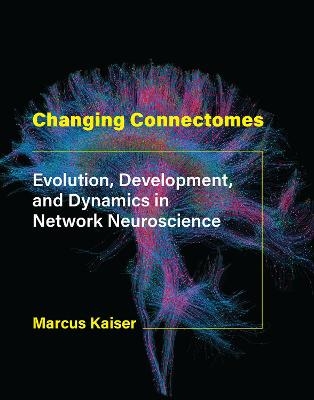
Changing Connectomes
Seiten
2020
MIT Press (Verlag)
978-0-262-04461-5 (ISBN)
MIT Press (Verlag)
978-0-262-04461-5 (ISBN)
- Titel z.Zt. nicht lieferbar
- Versandkostenfrei
- Auch auf Rechnung
- Artikel merken
The human brain undergoes massive changes during its development, from early childhood and the teenage years to adulthood and old age. Across a wide range of species, from C. elegans and fruit flies to mice, monkeys, and humans, information about brain connectivity (connectomes) at different stages is now becoming available. New approaches in network neuroscience can be used to analyze the topological, spatial, and dynamical organization of such connectomes. In Changing Connectomes, Marcus Kaiser provides an up-to-date overview of the field of connectomics and introduces concepts and mechanisms underlying brain network changes during evolution and development.
Drawing on a range of results from experimental, clinical, and computational studies, Kaiser describes changes during healthy brain maturation and during brain network disorders (including such neurodevelopmental conditions as schizophrenia and depression), brain injury, and neurodegenerative disorders including dementia. He argues that brain stimulation is an area where understanding connectome development could help in assessing long-term effects of interventions. Changing Connectomes is a suitable starting point for researchers who are new to the field of connectomics, and also for researchers who are interested in the link between brain network organization and brain and cognitive development in health and disease. Matlab/Octave code examples available at the MIT Press website will allow computational neuroscience researchers to understand and extend the shown mechanisms of connectome development.
Drawing on a range of results from experimental, clinical, and computational studies, Kaiser describes changes during healthy brain maturation and during brain network disorders (including such neurodevelopmental conditions as schizophrenia and depression), brain injury, and neurodegenerative disorders including dementia. He argues that brain stimulation is an area where understanding connectome development could help in assessing long-term effects of interventions. Changing Connectomes is a suitable starting point for researchers who are new to the field of connectomics, and also for researchers who are interested in the link between brain network organization and brain and cognitive development in health and disease. Matlab/Octave code examples available at the MIT Press website will allow computational neuroscience researchers to understand and extend the shown mechanisms of connectome development.
Marcus Kaiser is Professor of Neuroinformatics in the School of Computing at Newcastle University and Visiting Professor at Shanghai Jiao Tong University. He is a Fellow of the Royal Society of Biology and is Chair of Neuroinformatics UK.
| Erscheinungsdatum | 07.09.2020 |
|---|---|
| Sprache | englisch |
| Maße | 178 x 229 mm |
| Themenwelt | Medizin / Pharmazie ► Medizinische Fachgebiete ► Neurologie |
| Naturwissenschaften ► Biologie ► Humanbiologie | |
| Naturwissenschaften ► Biologie ► Zoologie | |
| ISBN-10 | 0-262-04461-7 / 0262044617 |
| ISBN-13 | 978-0-262-04461-5 / 9780262044615 |
| Zustand | Neuware |
| Informationen gemäß Produktsicherheitsverordnung (GPSR) | |
| Haben Sie eine Frage zum Produkt? |
Mehr entdecken
aus dem Bereich
aus dem Bereich
interdisziplinäre Diagnose- und Behandlungsstrategien
Buch | Hardcover (2024)
Urban & Fischer in Elsevier (Verlag)
CHF 135,75
Buch | Hardcover (2024)
Springer (Verlag)
CHF 195,95


